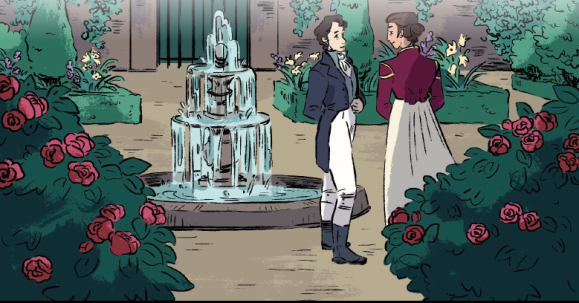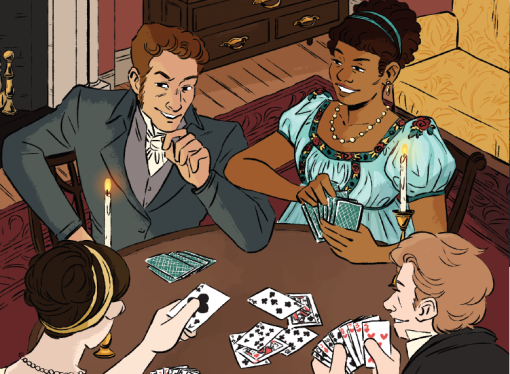I’m so excited about the game I’m reviewing today, Good Society. I helped to Kickstart this game after being completely won over by the tone and look of the game. This Jane-Austen-inspired game is both wholesome and tactical, it’s robust but straightforward, and it’s got a team of creators who are so enthusiastic and determined to make your game succeed. There are lots of different types of games out there and this one so excellently does what it sets out to do that I want to say up front that I think anyone even remotely interested should go out and get it.
As an example of how attentive and innovative the folks at Storybrewers Roleplaying are, they’ve produced a series of videos on how to play Good Society. They’ve done this before for their PbtA game Alas for the Awful Sea (which might see a review here in short order as well) but in this case they have fifteen (!) videos most of which are three to five minutes long.
One way to look at this is “Holy cow, you have to watch fifteen videos just to play this freaking game?” First off, no these videos are just meant to help get you up to speed. Secondly, I think the length of these videos is what turns it around. These videos are short and sweet, little snippets about the length of a song track which you can watch quickly to refresh your memory, gain some clarity, or prep players. Plus it’s clear that the creators love what they are doing which is just awesome.
Structure of the Book
The Storybrewers site says that this book will be “packed with over 150 pages of thematic material and beautiful art.” This is technically true but the final product clocks in at 280 pages so that seems like something to update on their site. The rules for how to play cover only about a sixth of that (around 42 pages including gorgeous art) which means the bulk of that is advice on running the game, stuff to let you know about the Regency era, and information to create amazing main characters.
This is a slim rules section but if you’re some sort of business magnate with no time on your hands, you can just watch the videos above to get the gist (particularly the backstory video, the resolve tokens video, the monologue tokens video, and the cycle of play video). If you don’t even have time for that (poor dear) I’ll attempt a bare-bones overview here.

Good Society is a diceless game with a narrativist focus that uses something called resolve tokens to resolve conflict. Every player gets two resolve tokens (some might get fewer, see the next section) and they spend them to do things like accomplish something difficult, mess up the plans of another player’s major character, and compel a major character to do something. In addition to their major characters (the story’s protagonists) each player takes on a connection (supporting character) associated with one of the major characters. Major characters have tag-based reputations and desires (secret but with public elements) that shape their behavior in the game as they interact. A Facilitator manages the game, particularly guiding people through the phases of the game: three to eight cycles of play each consisting of regular roleplaying (the Novel Chapter), a phase to reassess reputation, a round-table spitballing of rumors and scandals, an “epistolary phase” where players monologue letters their characters write, another novel chapter, another reputation phase, an epistolary phase (the epilogue if the story is ending), and an upkeep phase for book-keeping.
Characters and Stories
Characters in Good Society are built out of four elements, each with plenty of options to make for a dizzying number of possibilities. To cut down on the options, Facilitators are encouraged to pick out playsets that cover the group’s interests and a particular genre of Regency literature. The book suggests a handful of playsets collecting together game elements: tonal playsets of Farce, Romantic Comedy, and Drama as well as thematic playsets including Scandal and Reputation, Family Matters, and Rivalry and Revenge. There is a two-page guide, though, about creating your own playsets for your group.
Out of this playset, players choose desires for their characters which are printed on cards (either from Storybrewers or as a print-and-play option). Desire cards have Austen quotes on one side (for example “What is right to be done cannot be done too soon.”) some of which are repeated quotes. The back is unique for each of the twenty-two cards, however, and provides a secret goal for each character (the one above is “Restore your family name, and resume your place in society.”) and often a piece of Public Knowledge (“The scandal your family caused.”) with some additional instructions. I think it’s awesome that this all happens before you even know who your character is since it gets players thinking more creatively about their character. If you already know that your character is a military captain you might pick an action-oriented desire or something edgy. However, you might not know that’s the direction you’re going until you have a secret engagement under your hat!

Next we get into the meat of characters with the two elements that decide who they are rather than what they want. Players choose from fourteen relationship cards to tie their major characters together. Options range from “Child & Parent” to “Secret Fiancés” to “Old Flame.” Again, it’s awesome that this happens before you really know your character’s persona in the story as it challenges your expectations. It also simulates the vagaries of these social dramas: having a young dilettante who happens to be the rival of a foreign visitor is just the sort of thing that happens by chance but not the sort of thing you normally think up in a gaming group.
The last part of character creation would seem at a glance to be the most involved, but at this point you have a lot of what your character is story-wise. Their role is the Regency archetype that they fulfill, ten flexible character types like “The Heir,” “The Meddler,” and “The New Arrival.” These mix with eight different backgrounds that modify your role in the story from “Military” to “Old Money” or “New Money.” Some quick math gives you eighty (!) different characters to pick from, which is great since you aren’t supposed to double-up on roles (though you can double-up on backgrounds). These work like playbooks in PbtA games in that they give you game elements, but as there are no dice rolls or moves (as such) it’s mostly prompts for personality, reputation, etc.
After this you’re ready to wrap it all up a fleshing out phase to work out the finer details of the major characters. This is also the time to figure out the connections (supporting characters) which also involves a stack of cards to liven up the imagination of players. At the end you’ve got a tight little social net.

Game Resources
So this is all well and good but there’s the pesky little business of actually playing. If you’re not an Austen expert, or even if you are, figuring out how to portray a Regency character or how to tell a story in that period can be tough. That’s where Chapter 8 comes in.
There are plenty of setting notes in the character roles but this nine-page section of the book has sections like “Money is Crucial, but Fortunes are Capricious” and “The Marriage Market: The Only Market That Matters.” This should prep you for answering questions that might come up and how to strike the right tone. Following on this is Chapter 10 “Knowing Austen” which deals with exactly the sort of story elements common to Regency stories. From estates vs. towns, different sorts of entertainments, and the sort of tropes seen in these novels.
With that all said, you should play the game you want to play. All the way back in Chapter 2 there are prompts to consider what you want to do in your game. You can adjust the tone of the game, the historical accuracy, the gender relationships (I like the thought of a reverse patriarchy with women at the top), hidden information, and the X-Card. Add to this the forthcoming supplements Sense, Sensibility & Swordmanship and Pride, Prejudice & Practical Magic and you can see how flexible this game is for a group’s particular interests.

Conclusion
I spilled the beans at the beginning but I think this game is awesome. For all the reasons here, including the flexibility and tight mechanics, and for the sheer beauty of it. The illustrations are pitch perfect and they portray a vision of the Regency era that allows for the imagination to create a past that never was. The characters in the illustrations are diverse and the language in the book is both welcoming and elegant. There are plenty of options for gameplay as well from shortened games to longer games and even playing without a Facilitator. There are guides for online play and a host of free resources to help your game run smoothly. This can be whatever you want it to be whoever you are, and the focus on story as well as the smooth rules make it a great game for veterans and a great gateway game to get friends into the hobby.
Go buy this book.



I love these images! Sounds like a fantastic RPG!
LikeLike
I know! The illustrators they got for it hit the tone exactly in my opinion. Now I just need to find a group to play out a thousand games…
LikeLiked by 1 person
Looks very fun and beautifully put together!
LikeLike